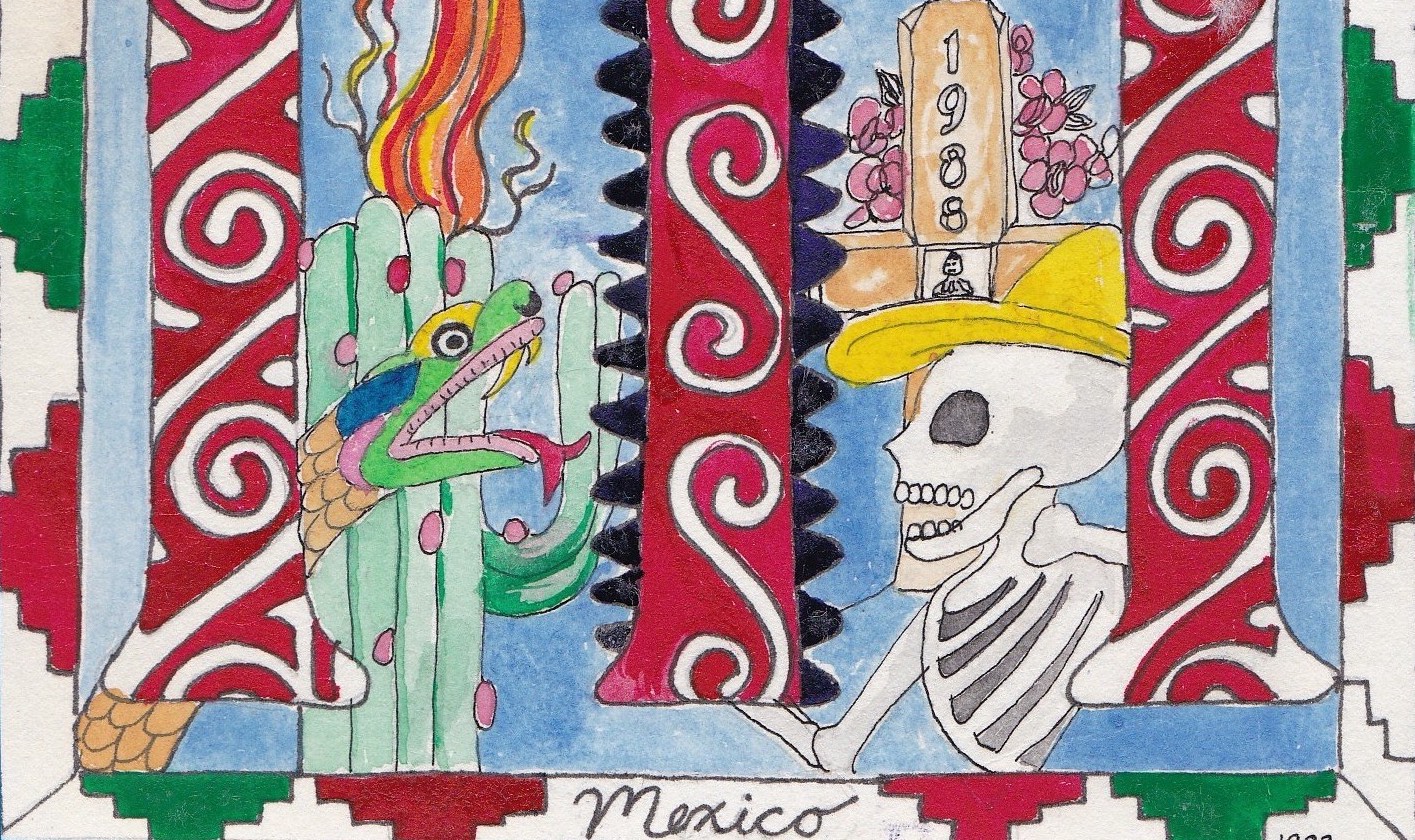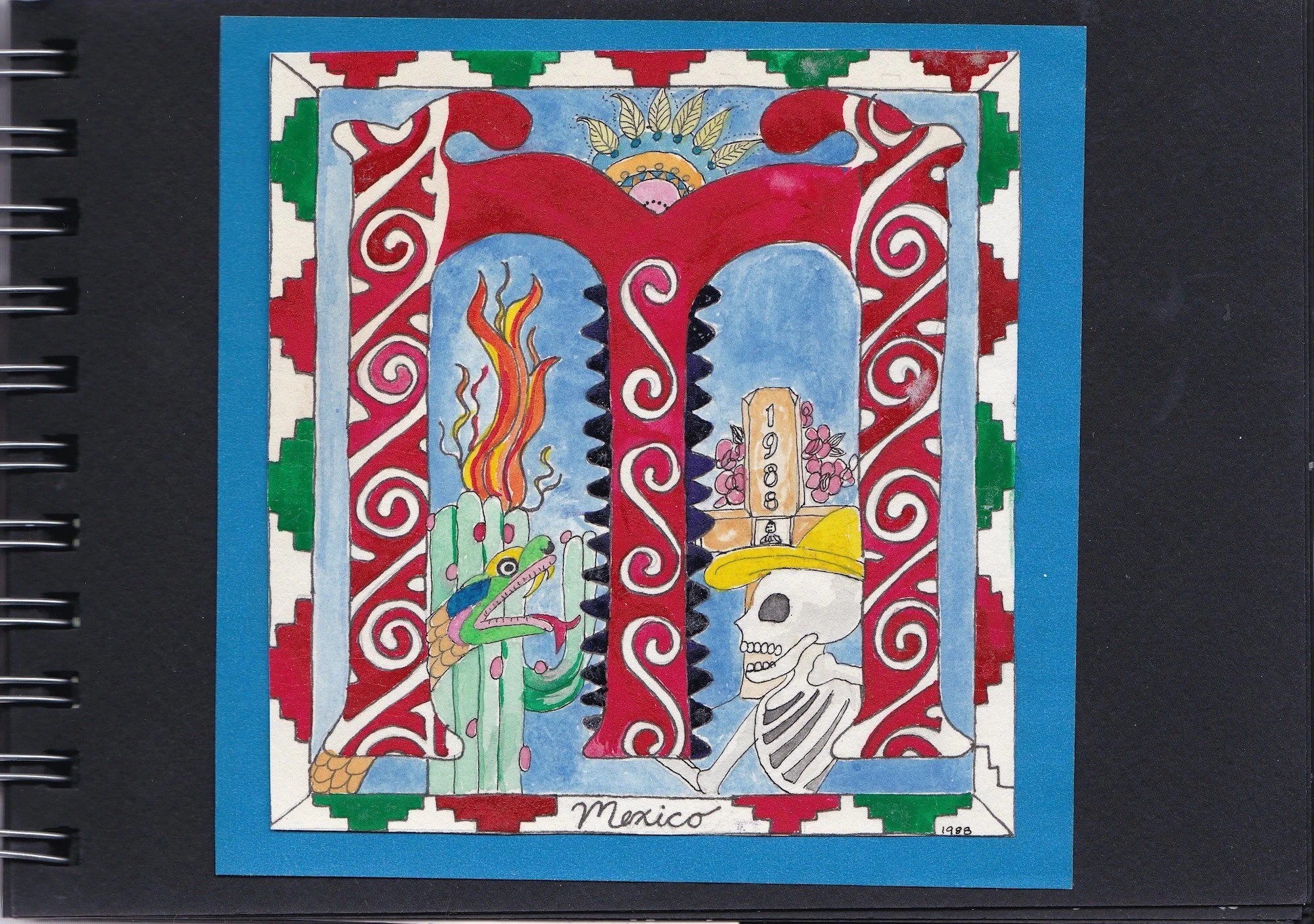1. Initiation

Prologue
Our first trip to Mexico was in 1968 in a VW bus. My husband, my small daughter, Heidi, and I were off into what was, for us, the unknown. For my husband Gary, a high school Spanish teacher, Mexico was the obvious and affordable choice. For me, a Navy brat, it was an opportunity to be on the road again. We had no idea when we drove across the border and out into a Sonoran oven of 120 degrees in our car with no air conditioning, that our first trip would set the tone for a lifetime. That very first day we rescued a delirious Mexican woman in a black dress in a broken-down black car along that deserted, black two-lane strip of highway, launching a lifetime journey on the thousands of miles of roads that web the country. We drove as many family members as we could into the next tiny town and got them the help of a doctor, then drove on, feeling we were already deep into the country. Virgins on the rocks, tomatoes in the ditches, the god of love in a truck, the memories continue to build with the miles.
People often ask if we are apprehensive about driving in Mexico. Our answer is always the same: Driving is half the adventure. That being said, we always make sure we are well protected. Dangling from our mirror is a silver medal showing San Cristóbal, patron saint of travelers, surrounded by trucks, cars, planes, ships and what looks like a covered wagon. Add to that a protective Tibetan knotted cord, and the mini-altar to the Virgin of Guadalupe stuck fast to the dash, and we are ready to roll. You just can’t be too careful.
* * *
Initiation
As our white Volkswagen camper labored over the 4,000-foot pass and began its descent into Imperial Valley, California, it seemed as if an oven door had magically opened and we were headed towards the hot, glowing element within. The green foliage of San Diego had now morphed into scrubby creosote bush and yellowed grasses of the Sonoran Desert. Sagebrush and gray dirt flashed past our window in a monotonous blur.
It was the summer of 1968, and we planned to cross the border into Mexico at Calexico. Gary and I sweltered in our VW hotbox and our five-year-old daughter, Heidi, fussed in her back-seat playpen. Her cheeks got pinker as the temperature rose to above 100 degrees on the valley floor.
I began to question our decision to drive into the unknown. I could barely tolerate the first ten minutes of valley heat. Gary and I talked about turning around. Our minds were filled with stereotypical images of men in white pajamas wearing huge sombreros, leaning against cacti (a favorite theme of salt and pepper sets). Our mental image of Mexico involved the myriad filmstrips and movies showing parched landscapes and sweating farmers. What if all of Mexico were as hot and forbidding as the Imperial Valley?
We thought we were prepared. Gary had made a large plywood box for the roof rack. We had read about bad water and tainted food that would result in the dreaded “turista,” so we had crammed the box with enough canned chili and creamed corn for our entire two-month trip. We had painted the box bright yellow and had lettered the words, Paz y Amistad, Peace and Friendship, on all sides.
Our confidence shaken, we spent a sleepless night at a campsite in the valley. The next morning, we discovered the fire ants. Not only did they bite, they left a souvenir, a red welt that itched long after they sampled us. There had to be more like them further south.
The morning air was somewhat cooler so we steeled ourselves, packed up and headed across the border. The temperature continued to rise, however, and was soon above 100 again. Saguaro cactus, gray-green mesquite, and yellow-gray dirt stretched as far as we could see. With no air conditioning, Heidi and I compensated by continuously wetting rags in the camper sink and draping them over our bodies, hoping to get cool. They dried in minutes but gave us a quick respite as the water evaporated.
The border crossing was uneventful and we headed out on the black ribbon of two-lane road, hoping for some kind of relief. We seldom saw another car and were beginning to think we were the only fools on this journey through hell.
We spotted a shape far ahead of us on the shimmering road. As we got closer, we could see a man waving his arms. Paranoia reigned and we discussed whether we should stop. This could be an ambush. There would be no one to help us if we got in trouble on this deserted road miles from nowhere. We saw a black Chevy sedan parked on the side of the road.
We finally decided that this person had no one to help him miles from nowhere in the middle of this broiling desert, so we pulled over. A stocky man in black pants and a white dress shirt hurried over to our car. Speaking in Spanish, he pointed to his vehicle and told us that his family was traveling south, taking his elderly mother to visit relatives. Their car had broken down. There was no shade. The air conditioning would not work. As cars seldom traveled this road, they had waited for hours until we happened along.
The doors to the car were open and we could see an elderly woman, plump and red-faced, leaning back on the rear seat, supported by another young Mexican man. Family members clustered around the door. The sun was at its apex, the car was black, and things were getting very serious for the family matriarch.
We shifted the gear inside our camper, making space for as many people as we could. We still had to leave some family members at the car with promises to send back help from the next town. The sons supported their mother and tenderly helped her up into the back seat of our van. They tried to give her water, but she was overheated to the point of incoherence and could only slump against the cushions. We draped her with wet rags, but the heat at this time of day and the blast of warm air that raced through our open windows rendered them useless.
This long-anticipated trip to bring their mother back to Mexico to visit relatives had now gone sour. We watched their tender ministrations as they tried to aid their mother, our first lesson in what was really Mexico.
The road was ruler straight and well-paved, and we drove as fast as we could. There was little talking in the car. Heidi, big-eyed and silent, tucked up next to me. We finally pulled into a tiny town. A few whitewashed shops and adobe houses lined the road. We spotted a motel sign and drove into the courtyard. The sons hurried in to talk to the proprietor and soon a flood of people descended on our car to help carry the woman to one of the rooms that had a fan. The proprietor called a doctor as the townspeople mobilized to help this family in need. A rescue car headed out for the rest of the family members.
We stayed until we knew our elderly passenger was in good hands, then crunched across the gravel of the motel courtyard and climbed back into our hot car. We were on the road again. We never heard the end of our first Mexican story but we felt sadness for that family that had set off on such a joyful trip, and we hoped theirs was a happy ending. We guessed that it would not be.
As we turned south, we talked about our first Mexican experience. We had faced heat, ants, and our own insecurities. But above all, we had made our first contact and had been able to help. We had seen a hint, both in the townspeople and in the family, of a network of caring and affection that would compel us to return to Mexico, time after time, for years to come.
* * *
All Content Copyright ©2020 Linda Oman | All Rights Reserved

